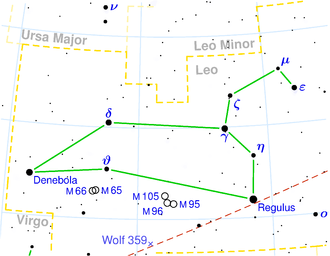IC 2810
| Galaxy IC 2810 |
|
|---|---|

|
|
| The galaxies IC 2810 (above) and IC 2810B (below) captured by the Hubble Space Telescope | |
| AladinLite | |
| Constellation | lion |
|
Position equinox : J2000.0 , epoch : J2000.0 |
|
| Right ascension | 11 h 25 m 45.0 s |
| declination | + 14 ° 40 ′ 36 ″ |
| Appearance | |
| Morphological type | SB? / LINER / LIRG / HII |
| Brightness (visual) | 14.4 mag |
| Brightness (B-band) | 15.2 mag |
| Angular expansion | 1.3 ′ × 0.6 ′ |
| Position angle | 30 ° |
| Surface brightness | 14.0 mag / arcmin² |
| Physical data | |
| Redshift | 0.034167 ± 0.000027 |
| Radial velocity | 10243 ± 8 km / s |
|
Stroke distance v rad / H 0 |
(454 ± 32) · 10 6 ly (139.3 ± 9.7) Mpc |
| history | |
| discovery | Max Wolf |
| Discovery date | March 27, 1906 |
| Catalog names | |
| IC 2810 • 2810A • UGC 6436 • PGC 35142 • CGCG 096-041 • MCG + 03-29-043 • IRAS 11231 + 1456 • 2MASX J11254505 + 1440359 • NVSS J112545 + 144036 | |
IC 2810 is an active spiral galaxy of the Hubble type SB? with extensive star formation areas in the constellation Leo on the ecliptic . It is an estimated 454 million light years from the Milky Way and about 175,000 light years across. Together with PGC 35136 , it forms an interacting pair of galaxies.
The galaxies IC 2799 , IC 2819 , IC 2821 , IC 2838 are located in the same area of the sky .
The object was discovered on March 27, 1906 by the German astronomer Maximilian Franz Joseph Cornelius Wolf .
Web links
Commons : IC 2810 - Collection of pictures, videos and audio files
Individual evidence
Attention: The sorting key "IC 2810A" overwrites the previously used key "IC2810".
